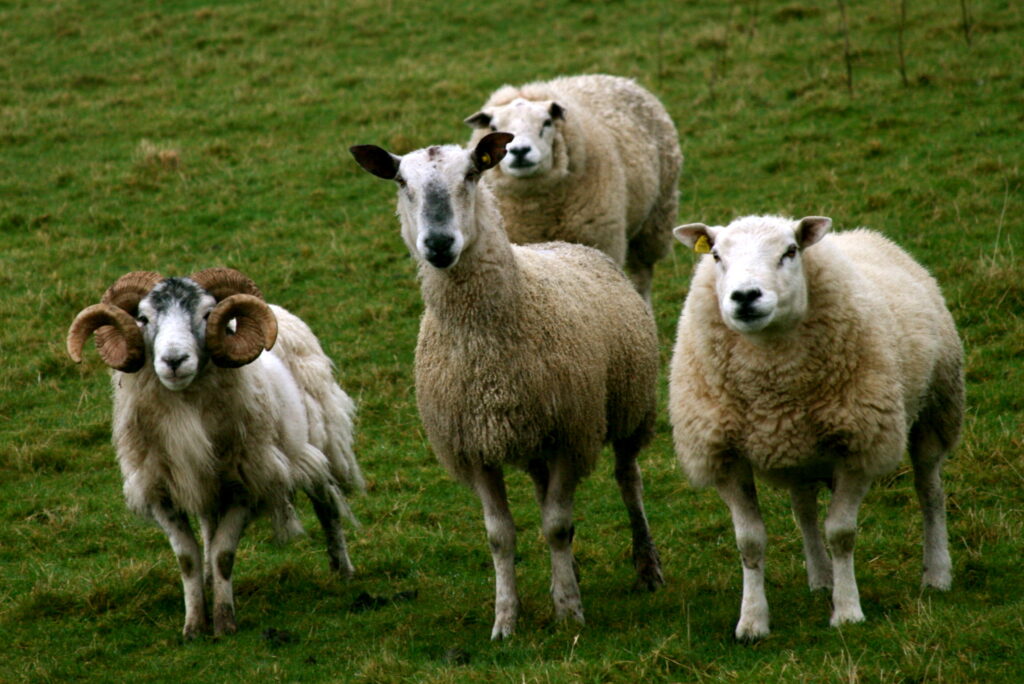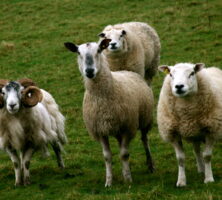Sheep have been raised in Georgia and the Southeast for centuries. Writings from the 1700s and 1800s suggest that lamb and wool production were important in those societies. The production and marketing of lamb and wool have been declining both nationally and in Georgia in recent decades. From a national high of nearly 40 million sheep in the 1940s, there are now about 7.5 million in the United States and fewer than 10,000 in Georgia.

Photograph by Mickey Champion
Constraints and Opportunities
Production constraints that serve to diminish the profit in this farm enterprise include the high cost and limited availability of labor, challenges with internal parasites, fencing requirements, a global oversupply of wool, and threats from predators. In recent years, however, there has been a renewed interest in sheep rearing in Georgia, and progress has been made in finding solutions to these constraints. Several factors are encouraging interest: there has been growth in populations that have traditionally consumed lamb meat; the state’s mild climate provides a long growing season for forages that sheep prefer, as well as a relatively long breeding season; more flexibility in lamb marketing has been achieved; sheep are small enough to enable family members to be involved in their daily care; sheep require smaller farm acreages than do cattle or horses; and there has been a growing interest in retaining ownership of wool and adding value through home spinning and weaving handmade products or selling wool blankets custom manufactured from the flock.
Breeds
There are more than 200 sheep breeds worldwide. Those traditionally used for meat production in Georgia have been the Suffolk, Hampshire, Dorset, Montadale, Southdown, and North Country Cheviot. The Rambouillet and Corriedale are used when wool is especially important. The hair-type breeds of Katahdin, Dorper, Barbados Blackbelly, and St. Croix are used in some systems. These breeds do not need to be sheared—a labor saving feature. They may be more tolerant of internal parasites than are the traditional breeds. Adult sheep of the larger breeds weigh, on average, 225 to 275 pounds. Those of medium-size breeds are about 175 to 200 pounds. Gestation length of sheep is about 147 days. Because most breeds are seasonal in their reproduction, lambs in Georgia are usually born in late winter and spring. The hair breeds tend to breed out of season and more readily produce lambs throughout the year.
Feeding
Sheep should depend primarily on forages—grasses, legumes, forbs (broadleaf weeds), woody plants—for the main part of their diet. They tend to prefer forbs as a major part of their diet, thus sheep act as biological weed-control tools. Large amounts of grain are not required in most sheep diets. If ewes are maintained on high-quality forage, they produce enough milk so that lambs are often ready for market shortly after weaning at 90 to 110 days of age. For figuring a suitable stocking rate, a general rule of thumb is that five or six mature ewes and lambs are the equivalent of one cow and calf. Rotating pastures helps increase pasture quality and may be of some benefit in controlling internal parasites.
Because sheep, cattle, and goats eat many different plants, grazing sheep with cattle can reduce the number of weeds in the pasture and increase the financial returns from each field. Sheep accumulate copper in their bodies more easily than do cattle, so they should not be allowed to eat much of the trace mineral mix usually provided for cattle and goats.
Health and Safety
Ewes should receive annual vaccinations against Clostridium (bacteria found in the digestive tract) type C and D to protect themselves and their lambs against enterotoxemia (blood poisoning caused by bacteria in the digestive system, which results in violent vomiting and diarrhea). Lambs should be vaccinated at four to six weeks of age and receive a booster about four weeks later. Sheep, especially lambs, are susceptible to infection from internal parasites (worms), which can be diagnosed early through routine fecal sample examination. By taking periodic samples, the producer is less likely to make the mistake of treating too often or not often enough. The owner will also know if the deworming medicine being used is effective. Lambs with heavy worm burdens lose the pink color around the inside of the eye, accumulate fluid below the jaw, and often develop diarrhea.
Neighborhood and wild dogs as well as coyotes are the most prevalent predators of sheep in Georgia. These days they can be adequately controlled through appropriate fencing and the use of guardian animals (dogs, donkeys, or llamas.)
Facilities for sheep can be simple. Protection from summer sun and from winter wind and cold is all that is needed. Fencing, for keeping sheep in and keeping predators out, can be of a woven type or multistrand electrified high-tensile wire.
Research and Education
The Georgia Small Ruminant Research and Extension Center at Fort Valley State University has a long-term sheep-production systems study that looks at biological, economic, and sociological issues associated with commercial lamb production. It also provides statewide extension services for producers of lamb and wool. The University of Georgia has a concentrated research program using new genetics that hold promise for improving the quality of lamb meat available in retail grocery stores.






